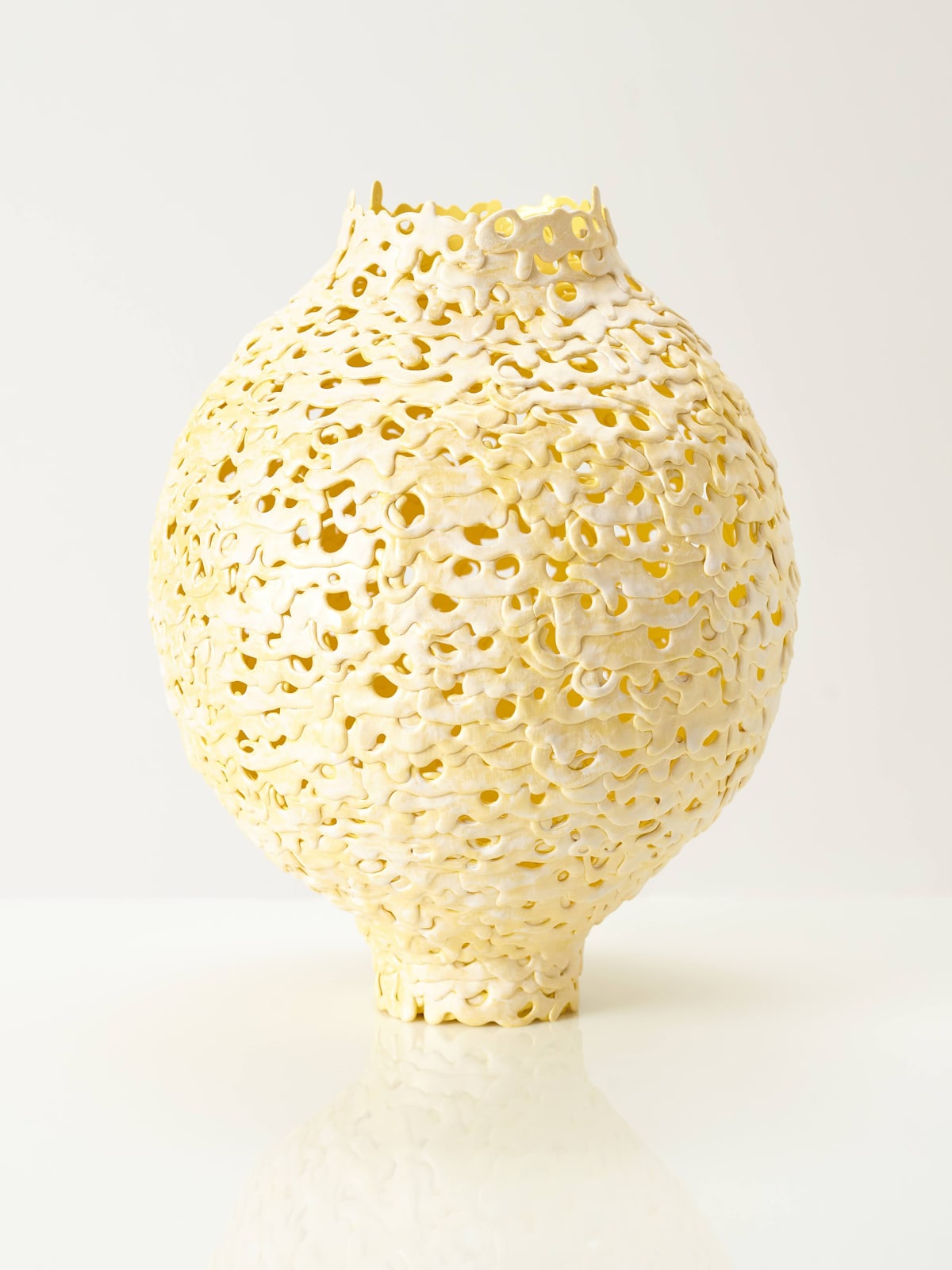

Mimi Joung
A Lot of Good Nights in Yellow Moon from Saturn, 2022
Porcelain, body stain, silver lustre
40 x 30 cm
Series: A Lot of Goodnights - In Watermelon Sugar
CF0478
Photo: Chuck Sangduk Bae
Currency:
This series is inspired and named after another chapter from ‘In Watermelon Sugar’ the book that has played a key role in Mimi’s work over the past years. In this...
This series is inspired and named after another chapter from ‘In Watermelon Sugar’ the book that has played a key role in Mimi’s work over the past years. In this case it is inspired by a very short chapter titled ‘A Lot of Goodnights’ and centres around her interest in the Moon. Mimi has been wanted to make her own version of the Moon Jar for some time, as culturally being a Korean artist in London, she feels very connected to the origins of the Moon Jar, named for its whiteness and near perfect round shape, made from a traditional Korean white porcelain, made during the Joseon dynasty. The Joseon white porcelain was adopted as imperial ware in the fifteenth century. Bernard Leach travelled to Korea and became an avid collector of Korean ceramics and furniture. He was drawn one Moon Jar in particular which he purchased in 1935 and gifted to Lucy Rie in 1943. She kept it in her studio until her death. Mimi feels very connected to the story of this Moon Jar travelling from Korea to the UK and now residing in London in the British Museum. Mimi has made a similar journey and wanted to create her own homage to the Moon Jar. Mimi references the influence too of Korean photographer Koo Bohnchang, famous for his wonderfully quiet photographs of rare white moon jars and vessels isolated or arranged in groups on white textured Japanese rice paper. He chose to photograph Moon Jars appreciated for their simple, unadorned beauty and he too was very preoccupied with the idea of the moon jar moving away from the country and moving to a multitude of museums in the West. It felt like himself moving away from home but always thinking about where he belonged. His work deals with the passage of time, capturing still and fragile moments, and the simple beauty of Korea’s cultural heritage. She likes this story of movement and how the moon provides a sense of nostalgia and belonging - we all gaze upon the same Moon so this unites us around the world.
For this series, Mimi didn’t want to make it a traditional smooth round shape and stick to white, she wanted to explore colour and form. Looking at the Moon from Venus, it appears white silver so she’s been using a pearl lustre to achieve this effect. She wanted the colours to be softer than in previous work, so used a silver lustre on some to create a subtle sheen and translucence allowing the colour to come through underneath – glowing almost like the moon. The surface is created in her distinctive method of using language written by hand in porcelain slip which is then coiled and built up to create the moon jar. Each one is made up of the written text from the chapter but in this series as the chapter is so short it repeats itself in each. She adjusts the heat of the kiln to create a more collapsed form which she wanted in one grey gradated piece to provide balance and contrast to the group. There is beauty in this gentle collapse which is planned, again highlighting the love of imperfection in Korean ceramics. The Joseon aesthetic was often stained, cracked and worn by everyday use bearing the traces of human life.
For this series, Mimi didn’t want to make it a traditional smooth round shape and stick to white, she wanted to explore colour and form. Looking at the Moon from Venus, it appears white silver so she’s been using a pearl lustre to achieve this effect. She wanted the colours to be softer than in previous work, so used a silver lustre on some to create a subtle sheen and translucence allowing the colour to come through underneath – glowing almost like the moon. The surface is created in her distinctive method of using language written by hand in porcelain slip which is then coiled and built up to create the moon jar. Each one is made up of the written text from the chapter but in this series as the chapter is so short it repeats itself in each. She adjusts the heat of the kiln to create a more collapsed form which she wanted in one grey gradated piece to provide balance and contrast to the group. There is beauty in this gentle collapse which is planned, again highlighting the love of imperfection in Korean ceramics. The Joseon aesthetic was often stained, cracked and worn by everyday use bearing the traces of human life.
Exhibitions
Selected ExhibitionsCollect 2022

